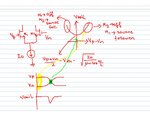niteshtripathi
Member level 3

The voltage at node P falls at the crossings of VX and VY if M1 and M2 do not enter the triode region at any point. On the other hand, if each transistor enters the deep triode region in a half cycle, then VP is low most of the time and rises at the crossings at VX and VY .
My question is that why vp is going low?
